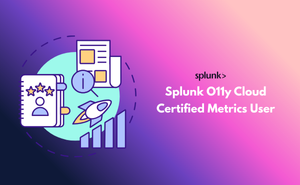👇 CELEBRATE CLOUD SECURITY DAY 👇
00
HOURS
00
MINUTES
00
SECONDS

The Splunk O11y Cloud Certified Metrics User certification is designed for professionals who use Splunk's Observability Cloud, focusing specifically on metrics monitoring and analysis. This certification validates a candidate's ability to leverage Splunk's tools and features to collect, visualize, and analyze metrics data effectively. It ensures that the individual can manage performance metrics, gain insights into system health, and troubleshoot issues using Splunk's observability features, contributing to enhanced operational excellence and data-driven decision-making within organizations.
Why is Splunk O11y Cloud Certified Metrics User important?
Who should take the Splunk O11y Cloud Certified Metrics User Exam?
Splunk O11y Cloud Certified Metrics User Certification Course Outline
The Splunk O11y Cloud Certified Metrics User Certification covers the following topics -
1. Get Metrics In with OpenTelemetry (10%)
2. Understanding Metrics Concepts (15%)
3. Understanding Monitor Using Built-in Content (10%)
4. Introduction to Visualizing Metrics (15%)
5. Introduction to Alerting on Metrics with Detectors (10%)
6. Create Efficient Dashboards and Alerts (10%)
7. Finding Insights Using Analytics (15%)
8. Detectors for Common Use Cases (15%)
Industry-endorsed certificates to strengthen your career profile.
Start learning immediately with digital materials, no delays.
Practice until you’re fully confident, at no additional charge.
Study anytime, anywhere, on laptop, tablet, or smartphone.
Courses and practice exams developed by qualified professionals.
Support available round the clock whenever you need help.
Easy-to-follow content with practice exams and assessments.
Join a global community of professionals advancing their skills.